Home Donate New Search Gallery Reviews How-To Books Links Workshops About Contact
California's Route 66
06 07 08 February 2015
These are snaps I made while helping lead Dave Wyman's tour of California's Route 66.
I brought my Nikon D810 with some of my favorite manual-focus NIKKORs, my Nikon 18mm f/4 NIKKOR AI, Nikon 35mm f/1.4 NIKKOR AI-s, Nikon Micro-NIKKOR 55mm f/3.5 AI and Nikon Zoom-NIKKOR 80~200mm f/4.5 N.
The 18mm was introduced in 1974, the optical design of the 35mm was introduced in 1969, the optics of the 55mm were introduced in 1956 for Nikon's rangefinder cameras, and the 80-200mm was introduced in 1977.
I also brought my 1950s Agfa Super Isolette, Kodak T-MAX 100 in 120 size and a set of colored filters for black-and-white (see How to Shoot Film). I haven't shot that much in 120 lately; the film I used and show here expired back in 2000 and it works great; it's sat in my freezer all this time.
I brought these because I prefer to shoot film when I shoot historical locations. Of course my Agfa is a real camera from the 1950s, but my Nikon D810 is digital. My D810 is so good that finally the files I pull from it are much better than if I had shot 35mm Velvia 50 and had it scanned, so I shoot my digital Nikon and I'm good.
I love my manual-focus lenses because they are all-metal and feel so much better and more precise in my hands than the offshored plastic garbage Nikon pushes today. As you'll see, the results from my 20 to 40 year old manual lenses first introduced 40 to 60 years ago are at least as good as from the bigger, heavier plastic autofocus zooms more popular today. Just click the 36 megapixel files and have a look for yourself. The only real differences with newer lenses is more automation, more plastic and no aperture rings; not better pictures.
I brought my Nikon 18mm f/4 NIKKOR AI because it's sharp, ultra-wide, and funny looking. My favorite are my 20mm lenses, but I hadn't used my 18mm in a while, so in my bag it went.
I brought my favorite Nikon 35mm f/1.4 NIKKOR AI-s because it's small, sharp, has a conventional 9-blade diaphragm for great sunstars, and it's my speed lens for low-light shooting. I've been using the 35/1.4 NIKKOR AI-s for decades.
I brought my Nikon Micro-NIKKOR 55mm f/3.5 AI because it's ultra-sharp, small, light, compact, and it focuses super-close. It's lighter than the f/2.8 versions.
I brought my Nikon Zoom-NIKKOR 80~200mm f/4.5 N because it's Nikon's smallest and lightest professional telephoto zoom of all time, it handles extremely well and takes normal 52mm filters. It's a dream to hold, focus and zoom, and it's super-duper sharp.
I set my D810 as I share in my setup file in the USAGE section of my Nikon D810 Review. I set it to VIVID Picture Control and +3 Saturation, and shoot as BASIC JPG files. I program Auto ISO and set Auto White Balance. I don't shoot raw, which is a beginners' format; I get better results with JPGs and letting my D810 create the files in-camera than using other raw software. See these colors? I can't get these with raw software; this is what I got right in the camera!
I never bring a computer in the field; I leave it all at home so I can concentrate on my shooting.
When I returned from the field, I had my film developed and scanned at NCPS.
I imported my shots from my D810 and my scans from the NCPS DVD into my Mac Pro.
I cataloged what I shot in Phase One Media Pro so I could see what I had, and then picked out the best.
I dragged the good shots from Media Pro into Photoshop CS6 to add subtle but significant artistic input, and to format them for publication. There's no rote application of formulas; I already have the image I need in my mind's eye and do whatever I have to to get it to look as I want it to look.
Most shots were processed with the Athentech Perfectly Clear version 2 Photoshop plug-in, which usually makes them look even better.
All my black-and-white works are split-toned prints.
For B&W from my D810, I used the B&W adjustment layer in Photoshop CS6 which allows me to set the effective color filtration after I've made my shot. Of course the shots from my Agfa are on real B&W film, shot through a filter.
The camera never matters. You'll notice that all my B&W shots have the same look whether I shot them on a classic 1950's folding medium format camera or a state-of-the-art DSLR. What matters is what's in my imagination, which is what gets out. Regardless of the tools, an artist always creates what he sees in his mind.
06 February 2015, Friday top
First stop: Tom's Welding in Barstow.
Old Filling Station Signs, Barstow, 3:58 PM. Nikon D810, Nikon 18mm f/4 NIKKOR AI, f/8 at 1/250 at ISO 100.
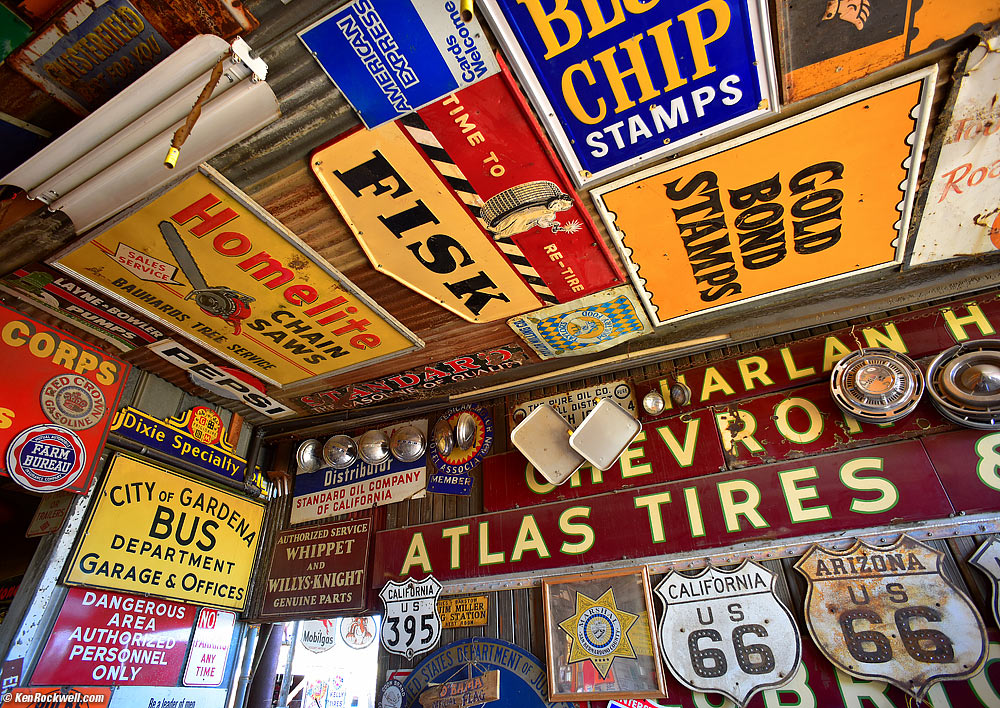
Old Metal Signs, Barstow, 3:40 PM. Nikon D810, Nikon 18mm f/4 NIKKOR AI, f/5.6 at 1/20 hand-held at Auto ISO 450.

Bar Stock Receding into the Distance in Black-and-White, 4:10 PM. Nikon D810, Nikon 18mm f/4 NIKKOR AI, f/8 at 1/15 hand-held at Auto ISO 180, split-toned print.
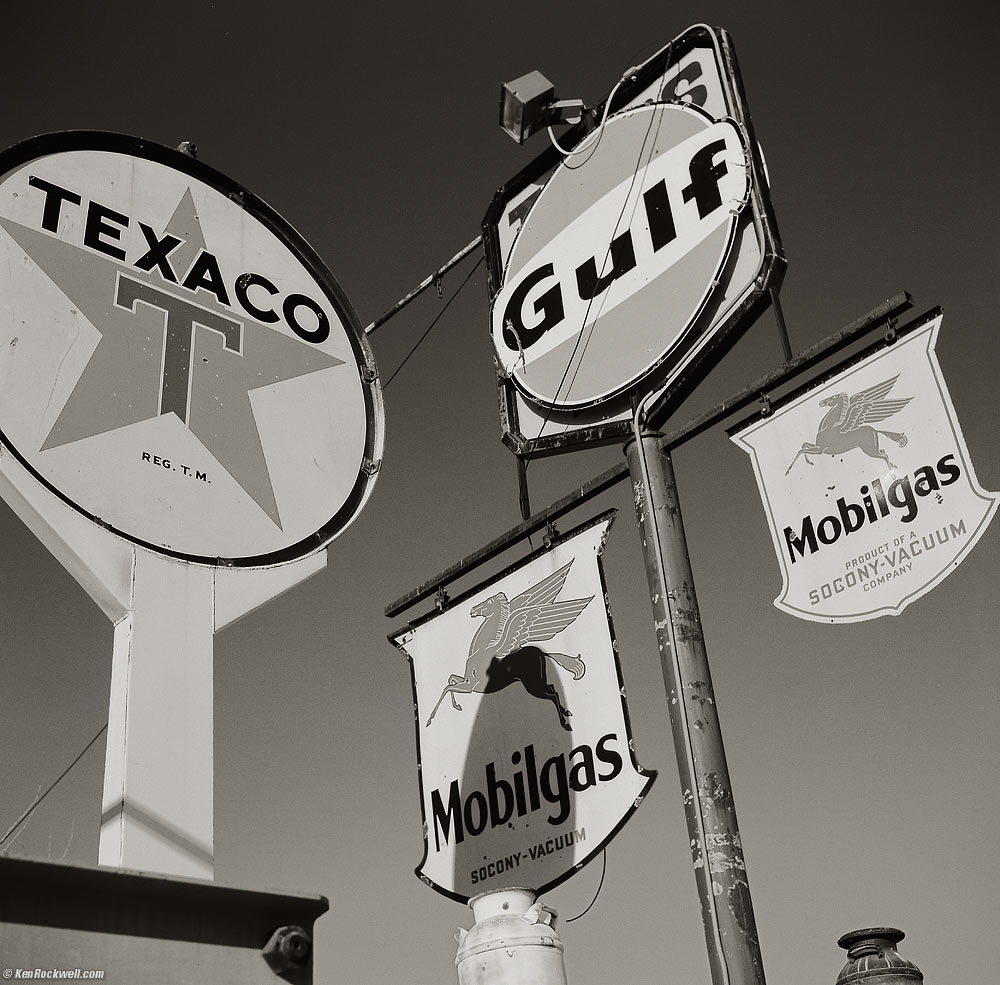
Old Filling Station Signs in Black-and-White, Barstow. Agfa Super Isolette, Kodak T-MAX 100, orange filter, f/5.6 at 1/100 marked (really 1/60), split-toned print.
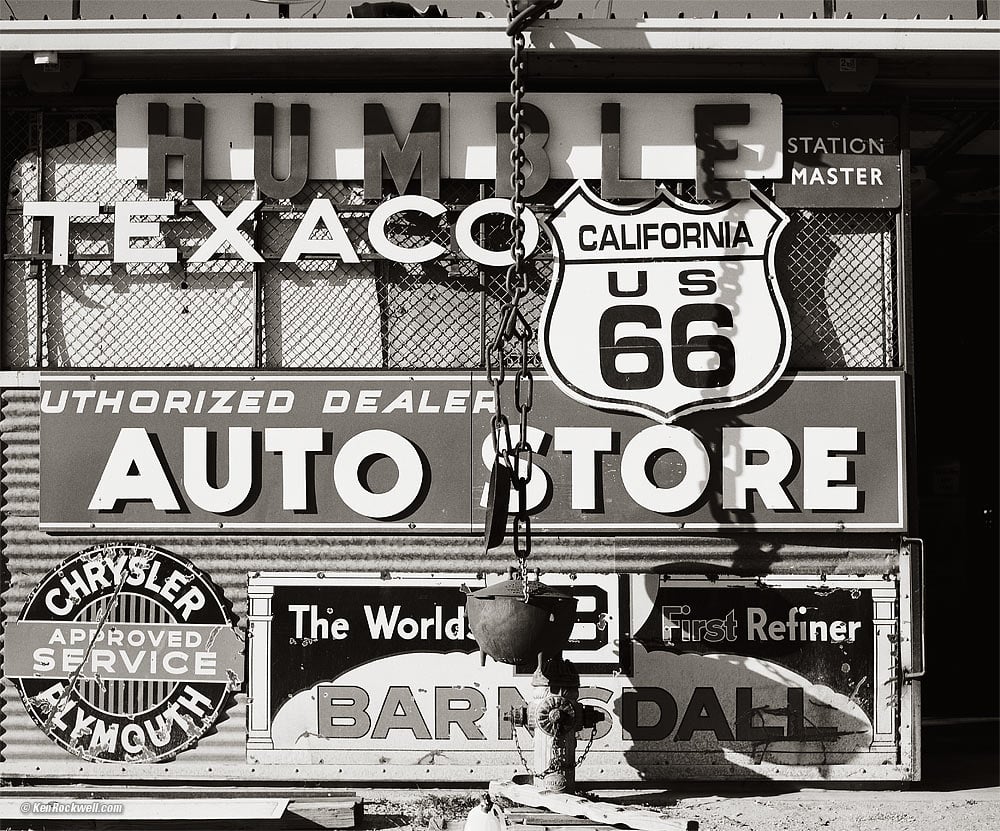
Old Filling Station Signs in Black-and-White, Barstow. Agfa Super Isolette, Kodak T-MAX 100, orange filter, f/8 at 1/100 marked (really 1/60), split-toned print.
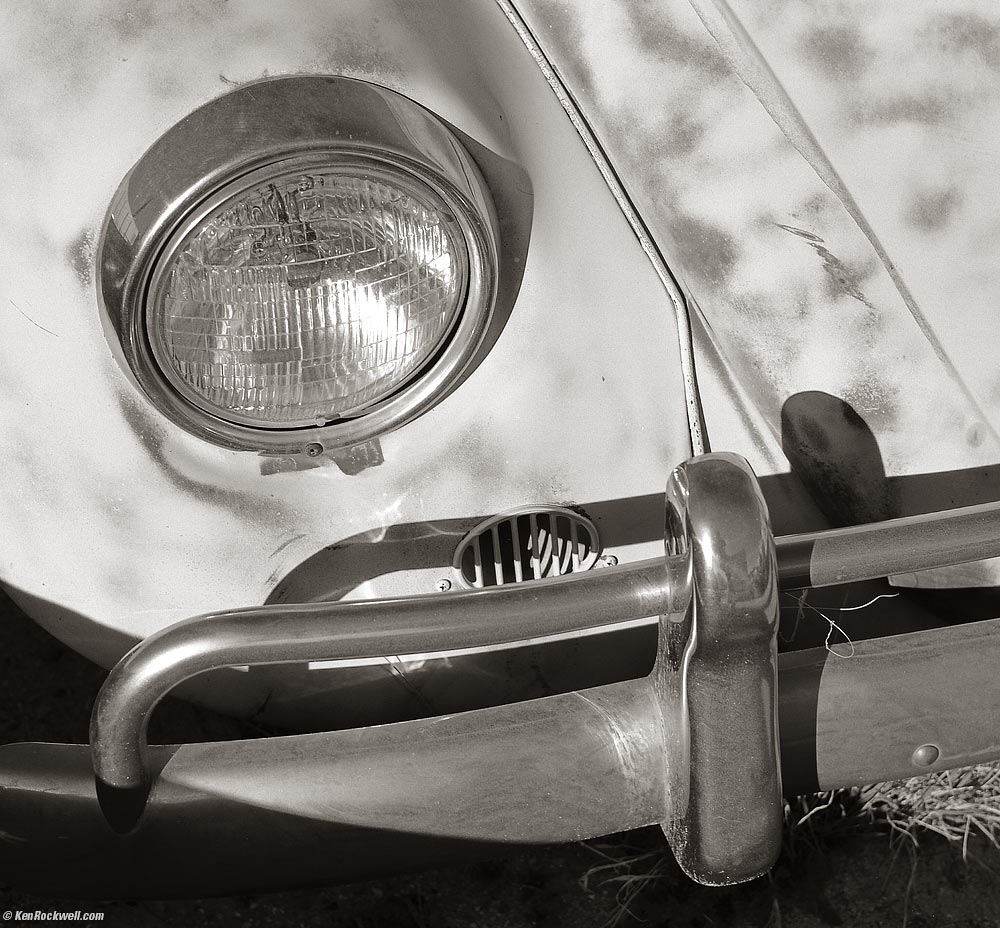
Old VW Beetle Headlight, Horn and Fender in Black-and-White, Barstow. Agfa Super Isolette, Kodak T-MAX 100, orange filter, f/8 at 1/100 marked (really 1/60), split-toned print.
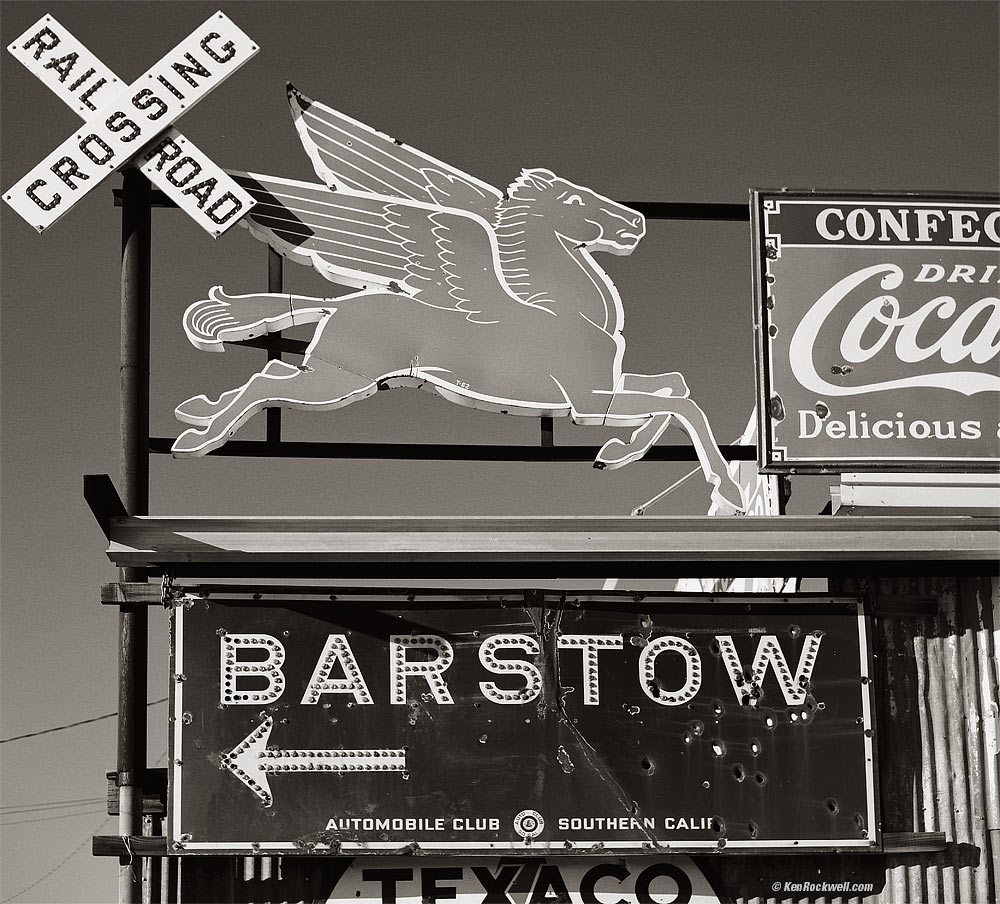
Old Mobile Flying Horse Sign in Black-and-White, Barstow. Agfa Super Isolette, Kodak T-MAX 100, orange filter, f/8 at 1/100 marked (really 1/60), split-toned print.
After Tom's, we headed east to an abandoned motel:
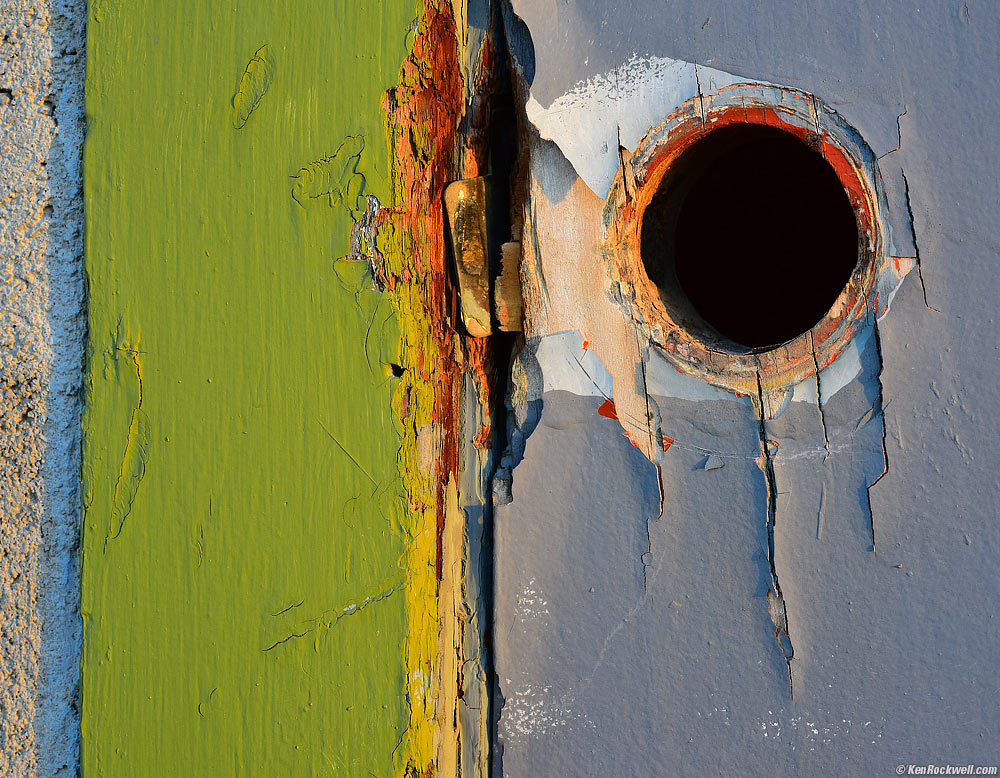
Last Light on Peeling Paint, Dunes Motel, West Barstow, 5:07 PM. Nikon D810, Nikon Micro-NIKKOR 55mm f/3.5 AI, f/8 at 1/60 at Auto ISO 450.
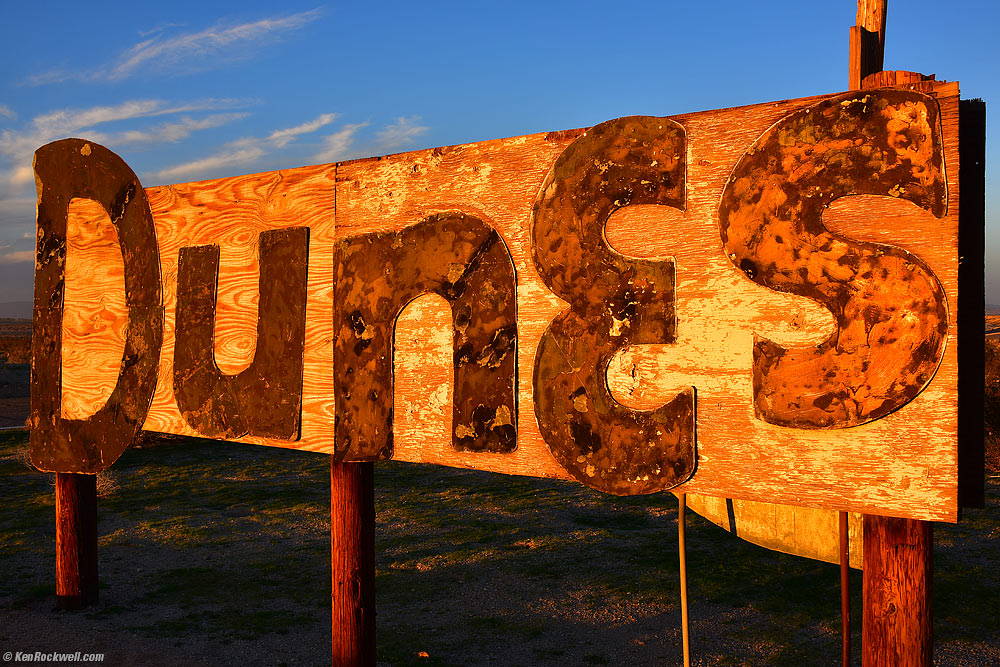
Last Light on Dunes Motel Sign, West Barstow, 5:07 PM. Nikon D810, Nikon 35mm f/1.4 NIKKOR AI-s, f/11 at 1/60 at Auto ISO 100.

Last Light on Windows with Shadow, West Barstow, 5:14 PM. Nikon D810, Nikon Zoom-NIKKOR 80~200mm f/4.5 N at 200mm, f/11 at 1/250 at Auto ISO 400.
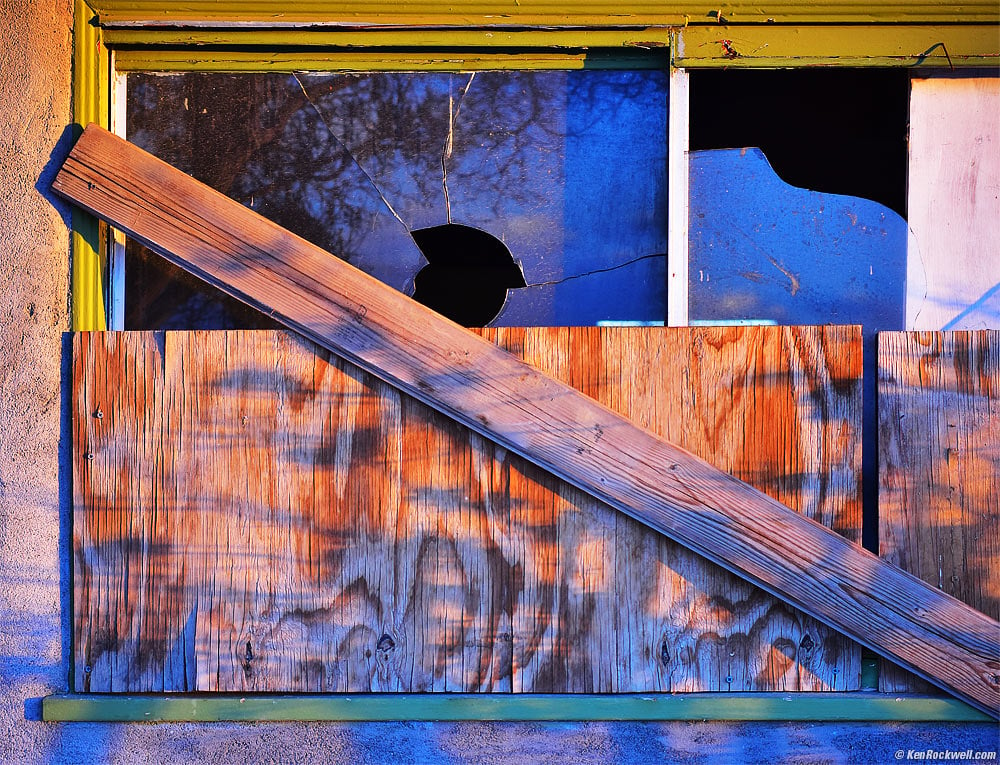
Last Light on Colorful Boarded-Up Broken Window, West Barstow, 5:14 PM. Nikon D810, Nikon Zoom-NIKKOR 80~200mm f/4.5 N at 80mm, f/4.5 at 1/80 at Auto ISO 560.

Some Kind of Tropical Plant in Black-and-White, West Barstow, 5:07 PM. Nikon D810, Nikon 35mm f/1.4 NIKKOR AI-s, split-toned print.
After the motel, we drove back into downtown Barstow.
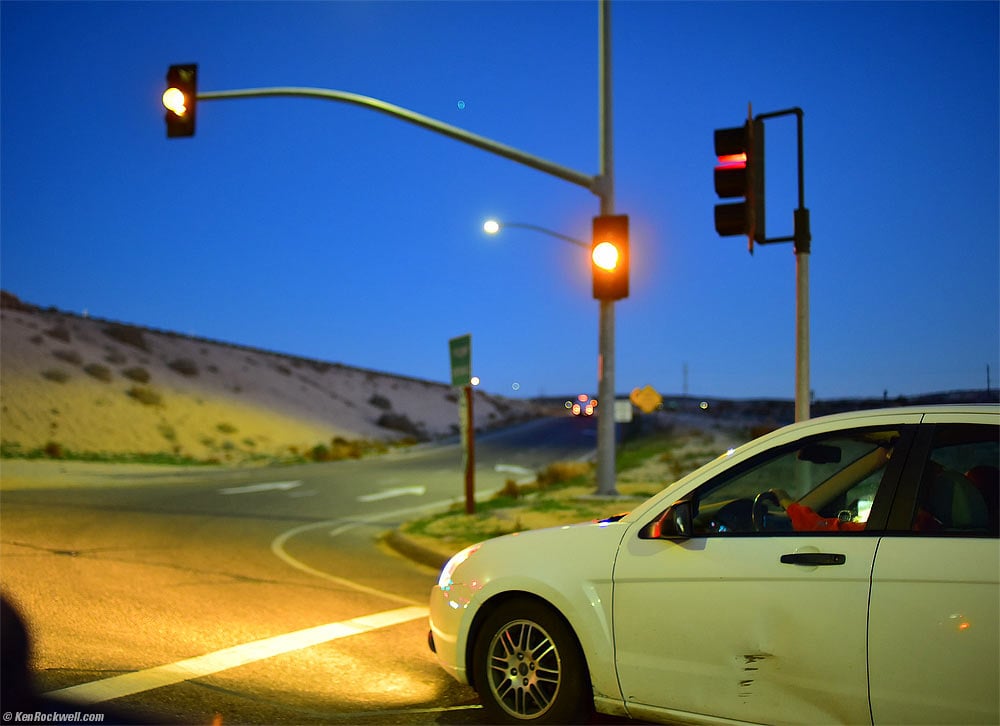
Colorful Intersection in Twilight, 5:49 PM. Nikon D810, Nikon 35mm f/1.4 NIKKOR AI-s, f/1.4 at 1/40 at Auto ISO 1,000. The dot in the sky is a planet rising.
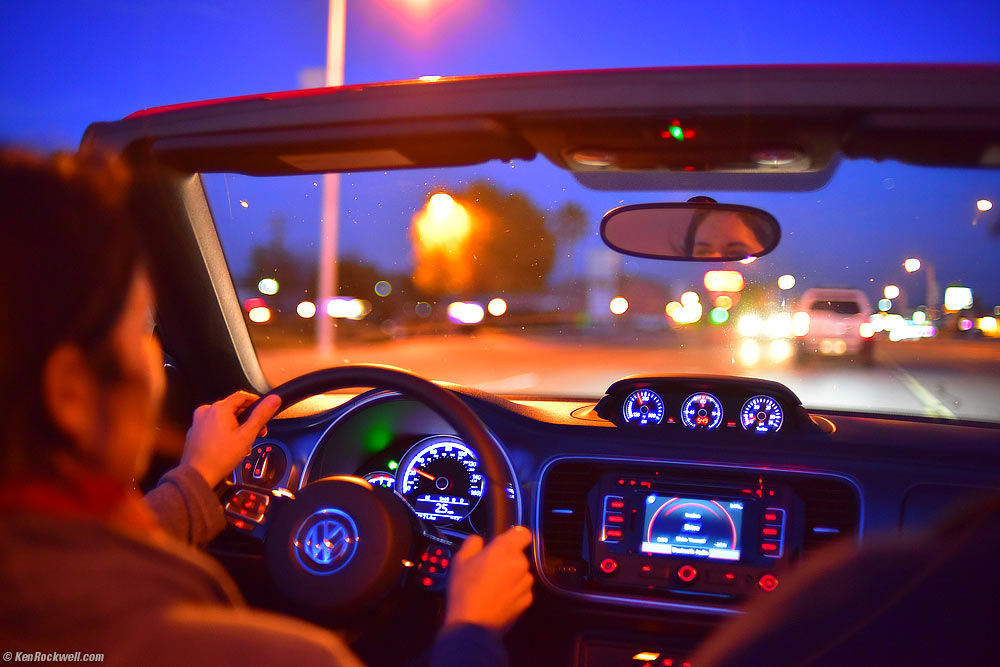
Riding in VW Beetle Convertible along Colorful City Street in Twilight, 5:52 PM. Nikon D810, Nikon 35mm f/1.4 NIKKOR AI-s, f/1.4 at 1/40 at Auto ISO 2,800.
After a fine Barstow dinner, we photographed at two of Barstow's finest lodging establishments:
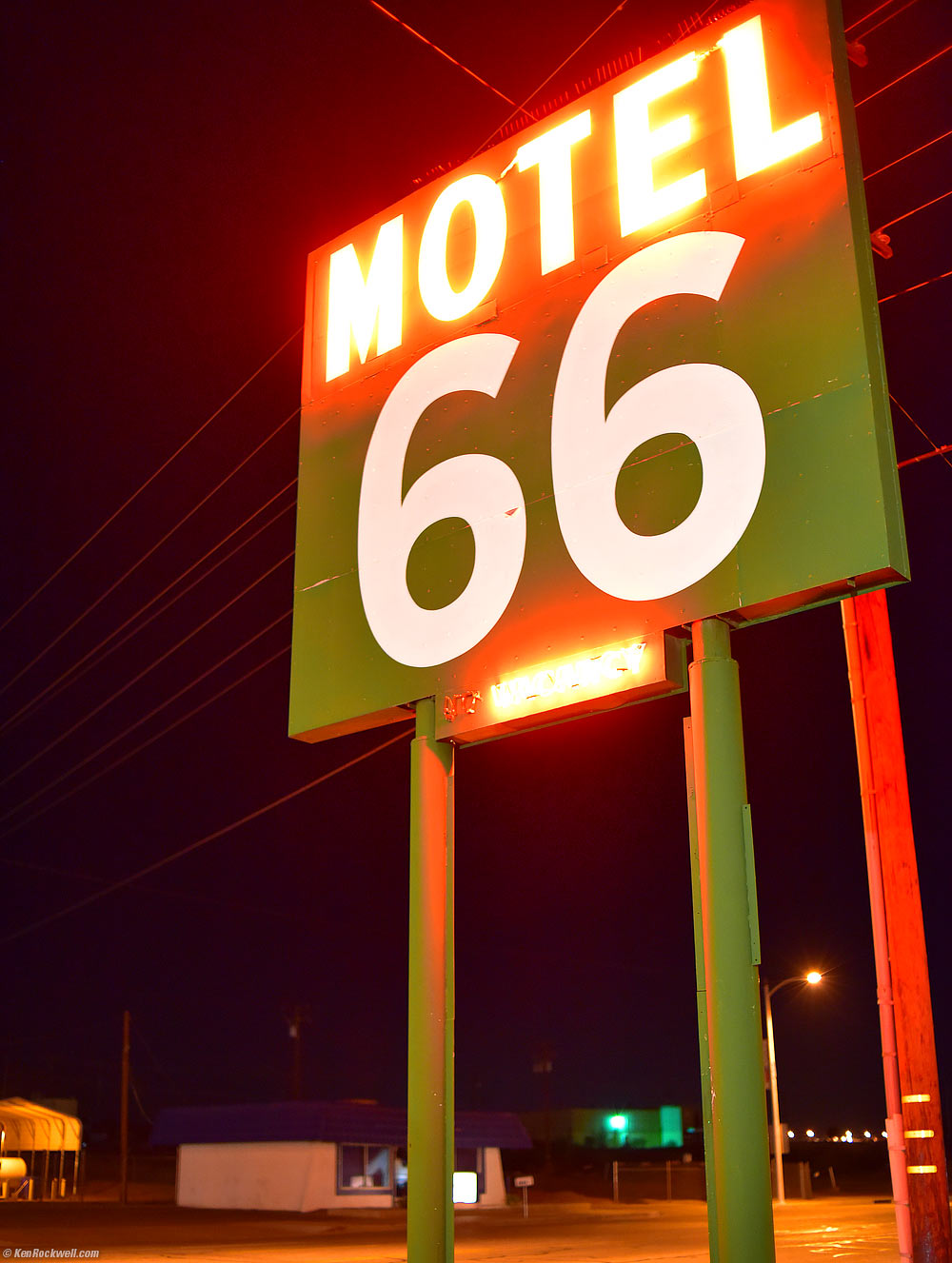
Motel 66 Sign at Night, 8:34 PM. Nikon D810, Nikon 35mm f/1.4 NIKKOR AI-s, f/2 at 1/20 hand-held at Auto ISO 2,500.
Colorful Old Route 66 Car at Night, 9:12 PM. Nikon D810, NIKKOR 35mm f/1.4 AI-s, f/11 at 30 seconds at ISO 100 on $50 Dolica GX600B200 tripod with Mini Magic Ball head, processed in Perfectly Clear.
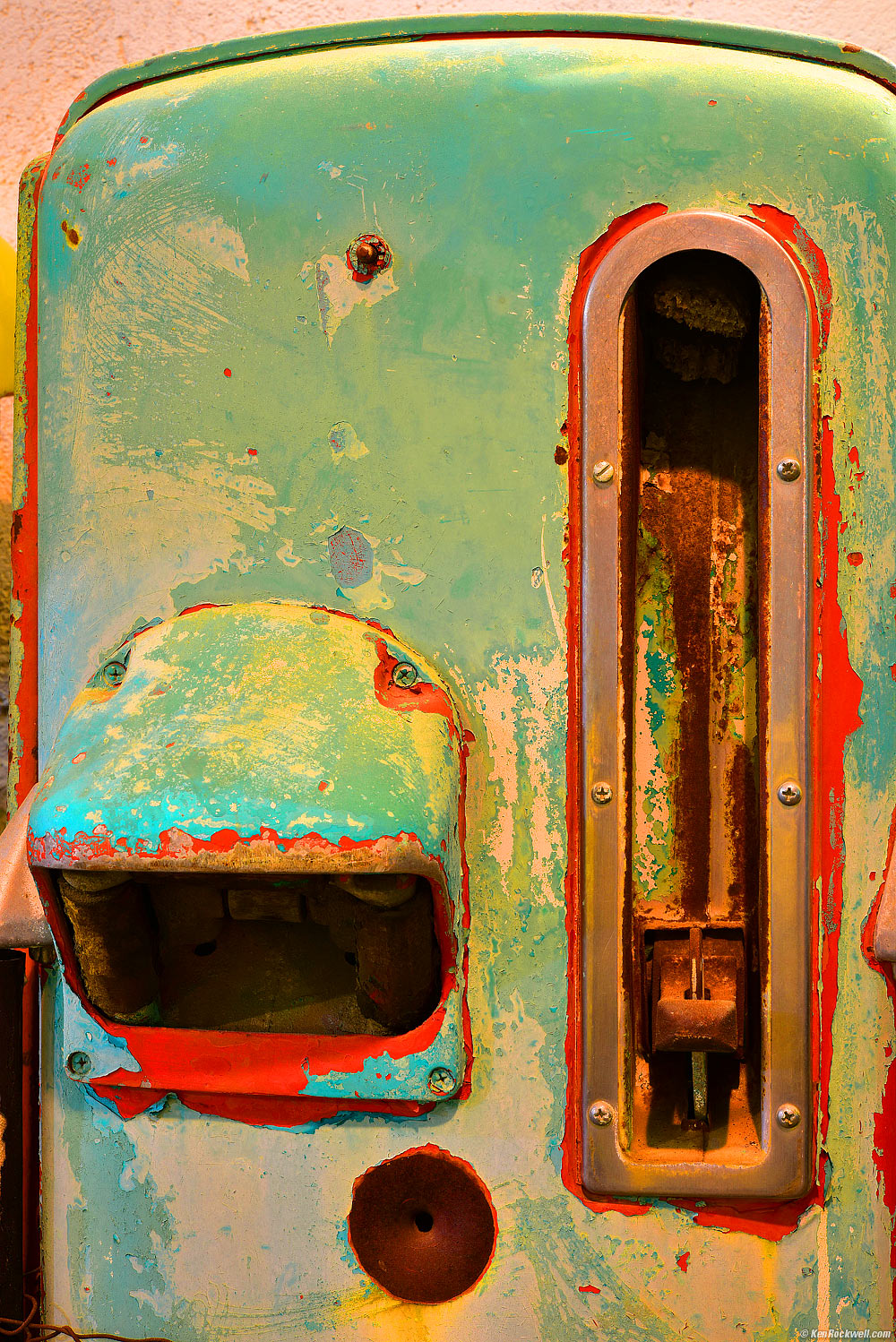
Close-up of Colorful Old Gas Pump, 9:31 PM. Nikon D810, Nikon Micro-NIKKOR 55mm f/3.5 AI, f/16 at 30 seconds at ISO 100.
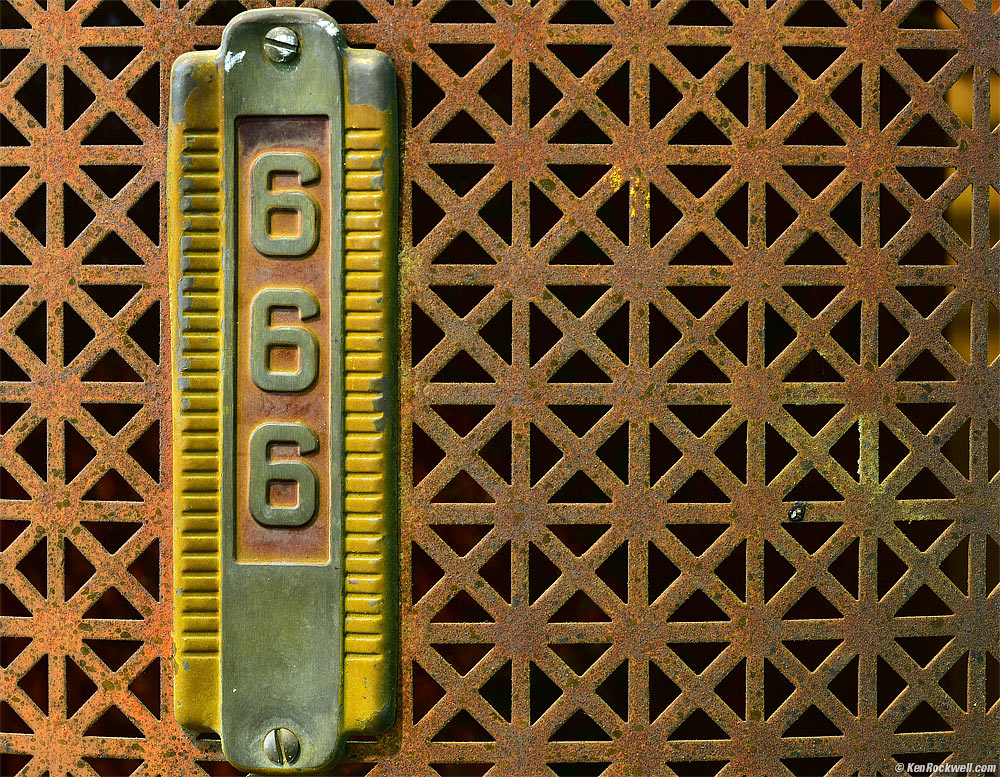
Burning Fires of Hell 666 Heater, 9:35 PM. Nikon D810, Nikon Micro-NIKKOR 55mm f/3.5 AI, f/8 at 30 seconds at ISO 100.
That's all for today. NEXT ->> 07 February 2015, Saturday
Home Donate New Search Gallery Reviews How-To Books Links Workshops About Contact

